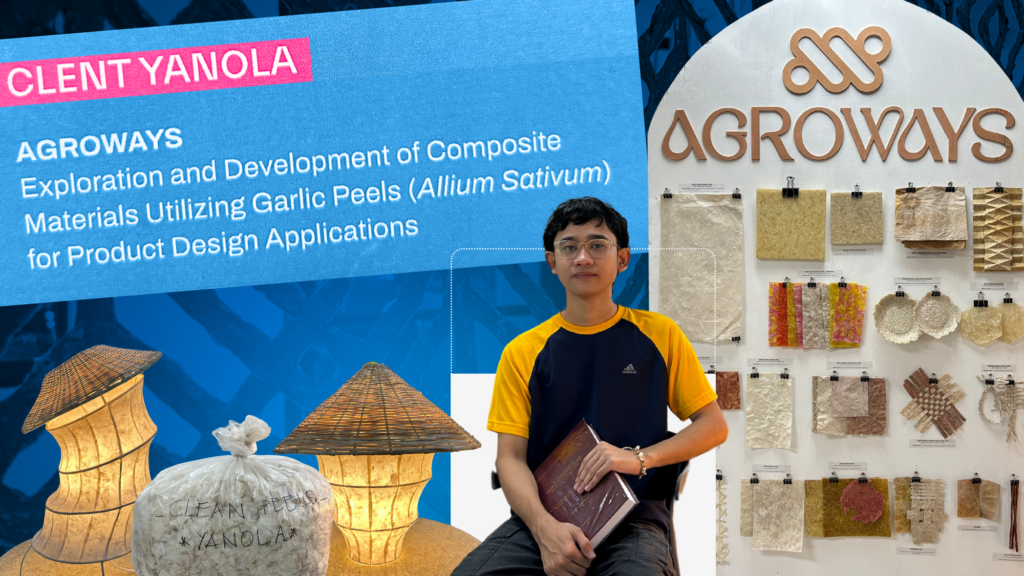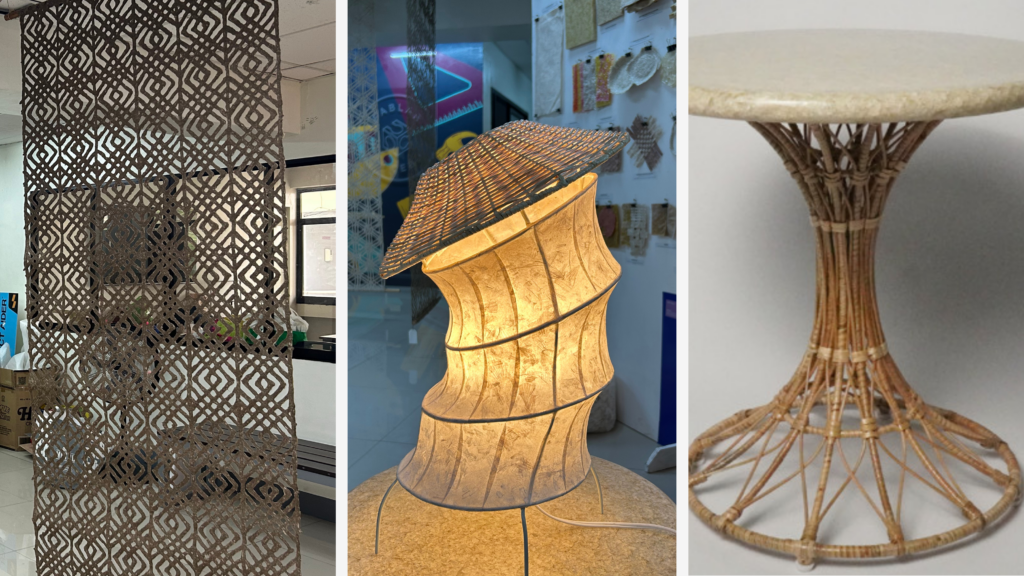
Clent Yanola, a Fine Arts student at the University of the Philippines – Cebu, went viral with his thesis on garlic peels. | GFX: Christian Dave Cuizon
Garlic is a staple in every bustling kitchen, whether in homes or restaurants. As a flavor enhancer and culinary necessity, it adds depth to a wide variety of dishes.
Yet, once their purpose is served, what happens to the humble garlic peels?
Often discarded without a second thought, this overlooked kitchen waste sparked a revolution in the mind of a 23-year-old Fine Arts student at the University of the Philippines-Cebu.
Clent Yanola is a promising artist and designer whose journey began not in the studios of Cebu, but in the fields and kitchens of his hometown, Hilongos, Leyte.
He is the student behind the viral TikTok video, which has garnered 3.3 million views as of June 25 and has been featured by national news outlets for his projects — furniture materials with exquisite designs made out of garlic peels.
READ MORE:
World Art Day: Meet the artist behind this uncanny face on the street
FACES OF CEBU: Jane Frances Latorza, 21, digital artist
FACES OF CEBU: Vince Dherek Joaquino, 19, visual artist
Where it all started
Clent was raised in a family where creativity was nurtured with practicality; his father was an engineer known for his meticulous craftsmanship, and his mother was a dedicated community leader.
Since his early years, Clent has already been filled with a blend of structured discipline and artistic exploration.
“Looking back sa ako elementary years, ganahan na gyud ko anang project projects na dapat extra gyud ako i-put na effort. And then mao to, elementary, ako gyud representative sa mga poster making and contests. Then high school pod kay dapat akong mga projects kay dapat “boogsh” gyud, the best gyud dapat,” he said.
(Looking back in my elementary years, I really those project that one would really put an extra effort to make it. And then, so, in elementary, I was really the representative of poster making and contests. Then in high school also because my projects should really be “boogsh”, it should really be the best.)
Clent’s love for art and design earned him recognition in his academic circles. He recalled a specific instance during high school when he was tasked with a report. His teacher scolded him because the designs on his manila paper overshadowed the minimal content.
“There was this one time gani nagreporting mi sa Araling Panlipunan, then sa akong manila paper kay mas daghan pa ang design kaysa sa content. Akong instructor nangutana, ‘Unsa man ako tan awon ana, imong design or imo content?,'” Clent recalled.
(There was this one time where we were reporting in Araling Panlipunan, then in my manila paper the designs were more than the content. My instructor asked, ‘what will I look for here, your design or your content?’)
READ MORE:
Cebu City flyover attracts onlookers with its vibrant colors
30 women artists, curators, designers, and art educators to watch out for in 2024
‘Art is not a practical career’
Despite his strong passion for art, Clent initially opted to pursue Political Science upon entering the university. He shared that art had not been prominently emphasized before, perhaps, due to its perceived risks as a career choice.
“Ang paghigh school, dili gyud ing ana ka dako ang pagtan aw sa Arts gyud. It’s not something or siguro ang society lang nga ang arts gyud is not a practical career. Risky gyud siya, so paggrade 12, while assessing unsa gyud ako gusto, and since I like reading, mao sad ako giconsider,” he said.
(When I was in high school, the way people look at arts was not that high. It’s not something or perhaps, only society see arts as not a practical career. It is really risky, so in Grade 12, while assessing what I wanted, and since I like reading, that is what I considered.)
He was also drawn to Political Science by a teacher who had graduated from UP and taught the subject. However, once he began studying Political Science, Clent started to feel that it was not the right fit for him. And ultimately, he found the program not aligned with his interests and future goals.
Shifting to Fine Arts
After one semester, Clent finally shifted to Fine Arts. He was inspired after seeing the creativity and success of other students in the Fine Arts department, which made him realize it could be a good fit for him.
He also evaluated his interests and capabilities and recognized that his true passion lies in creating art and projects.
“What’s more interesting kay wala pa gyud ko gasaba sa ako parents nga nishift ko. Nisaba na ko nila after one sem na. Mao to, nadisappoint sila nako kay nigraduate daw kog highest honors. Taas daw sila og expectation nako. Mao to ila gyud ko giconvince nga mubalik ko sa PolSci. So ako ato, ‘Bahala na. It’s my life, it’s my choice.’,” he said.
(What’s more interesting is that I did not let my parents know that I shifted courses. I only told them after I finished one sem. So that’s it, they really were disappointed with me because I graduated with highest honors. They had high expectation for me. That was why they really tried to convince me to return to PolSci. So, on my part (I told myself),’Whatever happens, happens. It’s my life, it’s my choice.)
When waste becomes art
The crucial moment in Clent’s career happened during his internship at Vito Selma, a well-known furniture design studio in Mandaue City, Cebu.
During this internship, he was tasked to find new, innovative materials for future collections. This task led him to explore Carbon Market, a busy marketplace in Cebu City where vendors sell a wide variety of items, from fresh produce to household goods.
“Nag search ko…Nag explore-explore ko’g mga material. Akong first na giexplore kay ang Carbon Market since didto man ko sige og palit og materials sa projects. During sa ako exploration, daghan ko og nakit-an like feathers sa manok, onions, mga waste material and finally, nakakita ko sa garlic peels,” he shared.
(I did a search…I explored different materials. The first one I explored was Carbon Market since it was here that I would often buy my materials for projects. During my exploration, I saw a lot like feathers of chickens, onions, waste materials and finally, I saw garlic peels.)
Clent was intrigued by the paper-like qualities of garlic peels, which made him curious about their potential to be transformed into paper or sheets.
He began testing various characteristics of garlic peels, particularly their translucency, which was essential for applications in furniture and lighting.
“Didto na nagstart ko og explore sa garlic peels,” he said.
(That is where I started to explore garlic peels.)
Clent regularly visited the vendors in Carbon Market who sold garlic to collect garlic peels. He would ask at least three to five vendors if he could collect the peels left after they sold their garlic, and some of them agreed to let him take the peels.
He would return after a few days to collect the plastic bags he had left with them.
In a humorous anecdote, Clent shared that one vendor grew exasperated as he already returned multiple times and jokingly urged him to make it the last visit.
“Funny story. Kay naa koy giduolan nga vendor, unya sige ko balik didto, mga katulo na siguro, pag ikaupat nakog balik kay niingon siya, ‘Dong, last na lang gyud ni dong.’ Gisamokan na gani sila kay sige ko balik didto. Kay ang mahitabo man gud, if magbilin ko og plastic didto kay moconsume siya og space didto, so feeling nako nga hasulan na sila,” Clent said.
(Here’s a funny story. Because there was this one vendor that I approached, I would often return there, I think it was already thrice that I went there, when it was the fourth time when I returned, he said, ‘Kid, this will be the last time.’ They, perhaps, found it irritating to see me return there several times. Because what happened, if I will leave a plastic bag (for them to place the peelings) it will occupy space there, so their feeling must be they felt irritated by it.)
He experimented with garlic peels by creating paper sheets, tiles, and molded receptacles. He mixed them with bioplastics, agar-agar, or seaweed extracts to create composite materials. He also experimented with dyes in different colors and crafted ropes.
Clent said that he decided not to use other waste materials or onion peels because they had already been extensively explored.
“Wala nako mitry og onion peels kay naexplore na siya. Ako sad na notice sa onion peels kay moaccumulate siya og daghan nga dirt. Dili gyud siya ing ana ka limpyo. Inigpeel nila, hugaw gani siya. Dili same sa garlic peels kay limpyo siya,” he said.
(I did not try onion peels because these had already been explored. I also noticed that onion peels would accumulate dirt. It is really not that clean. When you peel them, it is really dirty. Not the same as garlic peels that are clean.)
When he learned that garlic peels could make excellent sheets, he sought a manufacturer capable of processing these materials. He found a suitable facility in Tagaytay specializing in hand papermaking, which produces large sheets.
Curious if garlic peels had been used as a material before, Clent was informed that they were indeed novel. This spurred him to conduct extensive durability tests, considering factors like exposure to light, potential color changes, texture variations, and suitability for outdoor use.
He even tested how they would fare in air-conditioned environments to ensure they would not deform.
After Clent discovered the potential of garlic peels, he carefully considered their unique characteristics and how they aligned with his interests, strengths, and future portfolio needs in the furniture industry.
Clent produced numerous prototypes, driven to thoroughly explore the potential of garlic peels. Eventually, he narrowed down his focus to three stabilized materials.
He applied these materials in various forms: using sheets for lamps, tiles for tabletops, and creating pulp for tapestries.
Through extensive sketching, designing iterations, and seeking feedback from mentors and peers, Clent conceptualized the lamps, which focused on a more traditional aesthetic.
“The first lamp… ako gyud inspiration ana kay farmer siya while wearing a sarok. The second lamp…if imo siya tanawon mura siya og ga lean, ako inspiration ana kay kana bitaw mga farmer nga maglean sila magtanom,” he said.
(The first lamp … my inspiration for that is a farmer while wearing a sarok The second lamp…if you look at it, it seems to be leaning, my inspiration for that are those farmers that are leaning to plant.)
In parallel, Clent also designed a tabletop with a minimalist approach. He said he chose to steer away from avant-garde styles and instead opted for a clean, restrained aesthetic.
“My target audience included minimalists, enthusiasts of Scandinavian design, and those who appreciate wabi-sabi aesthetics,” he added.
In rural Leyte, his inspiration
When discussing the inspirations behind his creations, Clent explained that his design sensibilities were profoundly shaped by his upbringing in rural Leyte.
He shared that his childhood experiences and surroundings in Leyte had a huge impact on his artistic vision and the themes he explores in his work.
“I grew up in a very provincial community sa (in) Leyte so akong (my) inspiration kay akong (is because of my) upbringing,” he said.
He recalled the expansive rice fields and rustic surroundings that evoke imagery similar to that found in Amorsolo’s paintings, which have always influenced Clent’s artistic vision. He also finds constant inspiration in his father, who recently returned to farming.
The most challenging part
The most challenging aspect of this project, he said, was the phase of material development.
According to Clent, unlike paper, garlic peels are not naturally strong, so he needed to find ways to stabilize and strengthen them to make them viable for his designs.
This process, Clent said, required extensive exploration of reinforcing techniques, including combining them with other fibers and composites.
“Material development was the most challenging,” Clent said.
“We had to produce three products made from garlic peels for each meeting, and that demanded a lot from us. Throughout the term, I ended up producing around 50 prototypes. It was a continuous process of trial and error,” he added.
Each prototype represented a step forward in enhancing the durability and usability of garlic peel-based materials, pushing Clent to innovate and refine his techniques continually.
Provide livelihood opportunities
Following the success of his thesis projects, Clent’s short-term goal is to pass his thesis course and graduate. However, his long-term objective extends beyond just using garlic peels.
He aims to identify and utilize other types of waste materials that are often overlooked but readily available in communities.
“Akong long term goal gyud is mo explore beyond garlic peel material, mo explore more waste material na wala pa na notice or magamit pa before but something siya na abundant bitaw sa community…Something sad gyud in the future na makagive og livelihood sa community, makaprovide additional income nila, mao na akong long term goal,” Clent said.
(My long term goal really is to explore beyond garlic peel materials, to explore more waste materials that had not been noticed or used before but these are something that are abundant in the community…Something also in the future that can give a livelihood to the community, one that can provide an additional income to them, that is my long term goal.)
‘Keep doing what you love’
Drawing from his journey, Clent Yanola offers one piece of advice to encourage other product design students: persist in your passions and continually seek new opportunities and knowledge.
“Keep doing what you love. Keep exploring more.”



